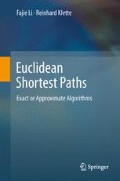Abstract
The introduction ended with recalling concepts in discrete mathematics as used in this book. This second chapter adds further basic concepts in continuous mathematics that are also relevant for this book, especially in the context of approximate algorithms.
I mean the word proof not in the sense of the lawyers, who set two half proofs equal to a whole one, but in the sense of a mathematician, where half proof = 0, and it is demanded for proof that every doubt becomes impossible.
Carl Friedrich Gauss (1777–1855)
Access this chapter
Tax calculation will be finalised at checkout
Purchases are for personal use only
Notes
- 1.
Heron of Alexandria (ca. 10–70) described this approximation method, which is also known as Babylonian method.
- 2.
Named after Baron Augustin-Louis Cauchy (1789–1857), who was central for establishing the infinitesimal calculus (e.g., of convergence of real numbers).
- 3.
Named after Bernard Placidus Johann Nepomuk Bolzano (1781–1848) and Karl Theodor Wilhelm Weierstrass (1815–1897).
- 4.
Named after Isaac Newton (1642–1727 in the Julian calendar, which was then used in England).
- 5.
It is named after Isaac Newton (see footnote on page 44) and Joseph Raphson (about 1648–about 1715).
- 6.
This paragraph was provided by Garry Tee, who also pointed out that a clear account of such convergence conditions (with illustrations) is given in Sim Borisovich Norkin’s textbook The Elements of Computational Mathematics, Pergamon Press, Oxford, 1965.
- 7.
Vatasseri Paramesvara (ca. 1380–1460) studied already mean-value formulas for the sine function. The theorem is due to A.-L. Cauchy (see footnote on page 37).
References
Aleksandrov, P.S.: Combinatorial Topology, vol. 1. Graylock Press, Rochester (1956)
Aleksandrov, P.S.: Combinatorial Topology, vol. 2. Graylock Press, Rochester (1957)
Ausiello, G., Crescenzi, P., Gambosi, G., Kann, V., Marchetti-Spaccamela, A., Protasi, M.: Complexity and Approximation. Springer, New York (1999)
Bartle, R.G., Sherbert, D.: Introduction to Real Analysis, 2nd edn. Wiley, New York (2000)
Boyd, S., Vandenberghe, L.: Convex Optimization. Cambridge University Press, Cambridge, UK (2004)
Hershberger, J., Suri, S.: Practical methods for approximating shortest paths on a convex polytope in \(\Bbb{R}^{3}\). In: Proc. ACM-SIAM Sympos. Discrete Algorithms, pp. 447–456 (1995)
Hochbaum, D.S. (ed.): Approximation Algorithms for NP-Hard Problems. PWS, Boston (1997)
Hromkovic̈, J.: Algorithms for Hard Problems. Springer, Berlin (2001)
Klette, G.: Skeletal Curves in Digital Image Analysis. VDM, Saarbrücken (2010)
Klette, R., Rosenfeld, A.: Digital Geometry. Morgan Kaufmann, San Francisco (2004)
Listing, J.B.: Vorstudien zur Topologie. Göttinger Studien, 1. Abteilung math. und naturw. Abh., pp. 811–875. Several missing proofs were later published by Tait, P.G.: On knots. Proc. R. Soc. Edinb. 9, 306–317 (1875–1878). A more recent review: Tripodi, A.: L’introduzione alla topologia di Johann Benedict Listing. Mem. Accad. Naz. Sci. Lett. Arti Modena 13, 3–14 (1971)
Mayr, E.W., Prömel, H.J., Steger, A. (eds.): Lectures on Proof Verification and Approximation Algorithms. Springer, Berlin (1998)
Papadimitriou, C.H.: An algorithm for shortest path motion in three dimensions. Inf. Process. Lett. 20, 259–263 (1985)
Rabani, Y.: Approximation algorithms. http://www.cs.technion.ac.il/~rabani/236521.04.wi.html (2006). Accessed July 2011
Roberts, A.W., Varberg, V.D.: Convex Functions. Academic Press, New York (1973)
Rockafellar, R.T.: Convex Analysis. Princeton University Press, Princeton (1970)
Vazirani, V.V.: Approximation Algorithms. Springer, Berlin (2001)
Author information
Authors and Affiliations
Corresponding author
Rights and permissions
Copyright information
© 2011 Springer-Verlag London Limited
About this chapter
Cite this chapter
Li, F., Klette, R. (2011). Deltas and Epsilons. In: Euclidean Shortest Paths. Springer, London. https://doi.org/10.1007/978-1-4471-2256-2_2
Download citation
DOI: https://doi.org/10.1007/978-1-4471-2256-2_2
Publisher Name: Springer, London
Print ISBN: 978-1-4471-2255-5
Online ISBN: 978-1-4471-2256-2
eBook Packages: Computer ScienceComputer Science (R0)

